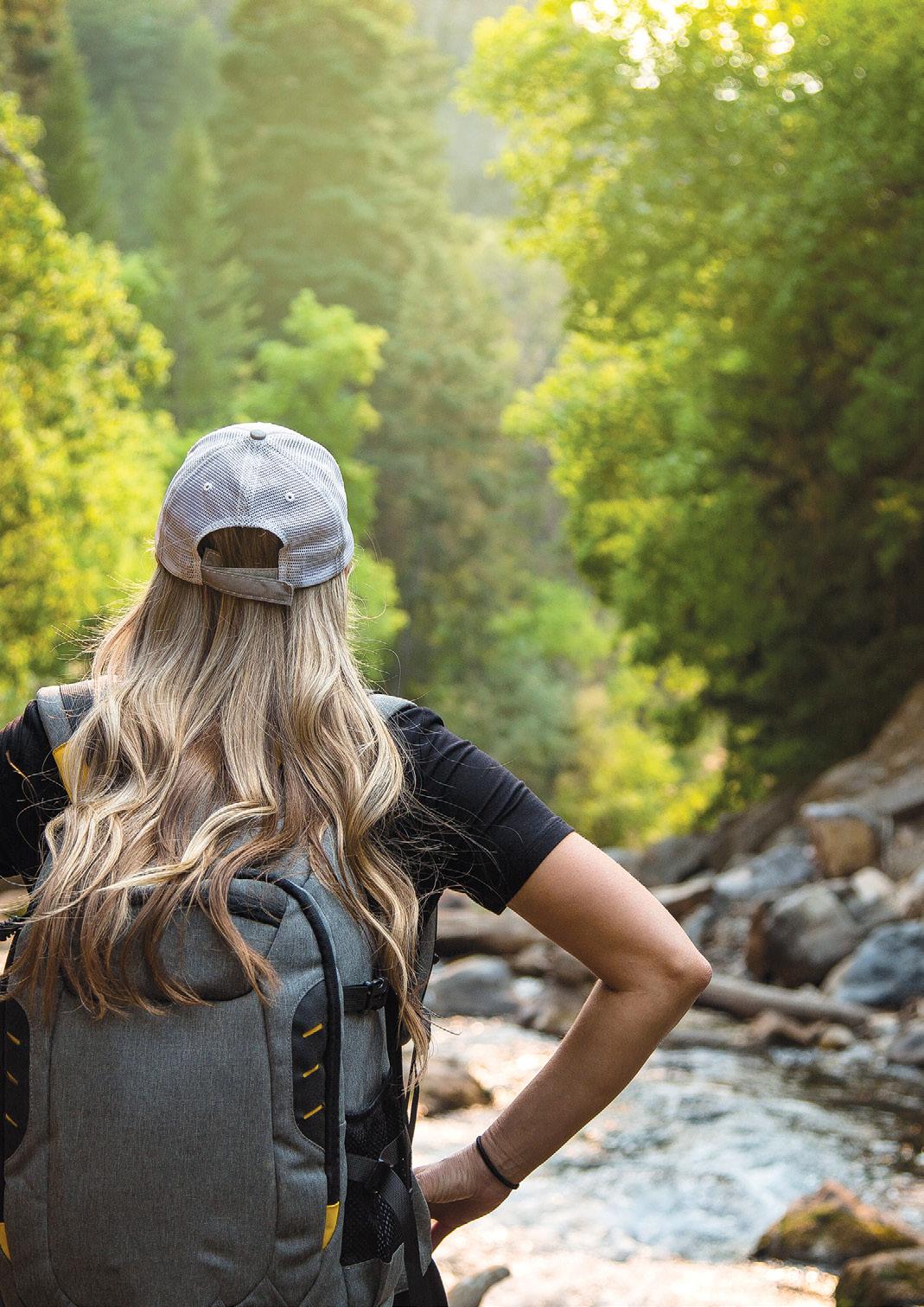
4 minute read
TAKE A SILENT HIKE
TIPS FOR WALKING MINDFULLY IN NATURE
by Sheila Julson
Advertisement
Brocreative/AdobeStock.com S ilent hikes offer an opportunity to be immersed in nature and quiet the internal chatter that too often consumes our daily routine. Wesley Trimble, communications and creative director of the American Hiking Society, has observed a growing interest in ecotherapies such as silent hikes that meld solitude and mindfulness with outdoor recreation. “Just getting out into nature, no matter where you are, is a great way to enjoy its beauty and focus on the experience,” he says.
When heading out on a silent hike or walk, in a group or alone, in a park or around the neighborhood, Trimble recommends taking long, deep, deliberate breaths. This allows the body to relax and focus on moving through space while being aware of sensory experiences.
Acoustic ecologist Gordon Hempton takes a quiet hike every day. The author of One Square Inch of Silence has traveled the globe for four decades in search of quiet, natural spaces in which to record ecological soundscapes such as crashing ocean waves or the snowy crickets of Washington State. “Opening up in a naturally quiet place in nature or the wilderness lets you become physically healthier, mentally clearer and more in touch with what you really want,” he says.
Hempton suggests that a silent hike begin with listening, which for mammals is a primary way to gather information: “Any event creates a sound, and that sound carries information about that event.” When heading into a natural area, he recommends listening for the furthest sounds and focusing on the faintest ones. “Then listen to the whole place and notice what you feel. There’s nothing you need to say, but everything you need to hear.”
According to Hempton, it takes less time to enjoy the benefits of a silent hike than people might imagine. “Even five minutes can produce huge relief,” he says. “Don’t make it a stressful thing. Recognize how much time you have, give it that and notice how you feel.”
Advice for silent wilderness experiences can be found at the website of Quiet Parks International (QuietParks.org), a nonprofit that Hempton co-founded which is dedicated to preserving quiet in the wilderness.

Exercises to Quiet the Mind on a Silent Hike
Author and nature educator Joseph Bharat Cornell affirms that silent hikes help instill a sense of vibrant calmness. He created an outdoor learning strategy named Flow Learning, which is highly recommended by the U.S. National Park Service. It incorporates C playful experiences into wellness walks to lessen internal dialogue M and sharpen intuitive perception. Y
His book, Sharing Nature: Nature Awareness Activities for All CM Ages, includes activities like the Silent Sharing Walk. “Teams of three people walk along and don’t say anything, but look and MY CYenjoy together,” he explains. “When you see something intriguing, CMYgently tap the others on the shoulder, point and look together, and then quietly move on.” K
The Trail of Beauty exercise encourages hikers to consider quotations like George Washington Carver’s “If you love it enough, anything will talk with you.” Participants explore trails to find something captivating that relates to the noteworthy words. Cornell advises to not use quotes that are too philosophical, because that can lead to internal dialogue that takes focus away from nature.
Group hikers can use the Nature In Me exercise to develop points of awareness. After finding a captivating spot outdoors, participants sit down and rest their hands palms-down on their thighs, allowing awareness to flow from one observation to the next. Lightly press a finger on the leg for each noticeable observation—a passing cloud, chirping birds or the splash of a river otter. Cornell advises against slipping into passivity, because then the mind tends to wander.
The Sound Map activity encourages hikers to take paper and pencil on a silent hike. “Close your eyes and cup your hands around both ears and listen for a sound,” Cornell explains. "Mark an X at the center of your paper to represent where you are. Then make a simple symbol to represent your sound and its location. This encourages people to listen and focus.” Trimble cautions that silent hikes can increase the chances of an animal encounter, so it’s important to remain aware of surroundings at all times. Silent hikes can also help wildlife. “One of the components of ‘leave no trace’ is the respect of wildlife,” he says. “Many studies show the impact of noise pollution on different types of ecosystems. Silent hikes let us enjoy nature without disturbing wildlife.”
Sheila Julson is a freelance writer and regular contributor to Natural Awakenings magazines throughout the country.
Cheryl Tuttle & Marcy LaBella Earthlygoddess02@gmail.com
Clay
Drawing
Painting
Fiber Arts
Jewelry
Mixed Media
860•349•0251
352 Main St.-Rear Durham, CT 06422 Check out our class schedule in the calendar section! facebook.com/earthlygoddess3
KCC_bc_final_vendor2.pdf 1 10/25/15 11:26 AM
Final Journey, LLC
(Pet Euthanasia Service) Kristen Klie, D.V.M. and Associates
(203) 645-5570 www.finaljourneyllc.com
Maintain your youth
with Homeopathic HGH Transdermal Gel Maximum Strength Somatropin
Unique and affordable alternative designed to support your pituitary gland! Usage may
• Improve Bone and Joint Health • Improve Sleep • Increase Muscle and Reduce Fat Contact Shirley R. Bloethe 860-989-0033 or www.PassItOnLLC.com




